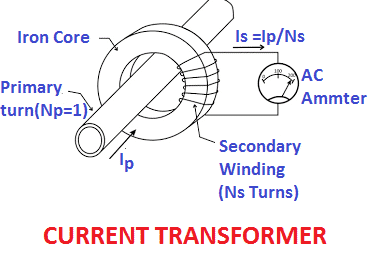The current transformer is used for measuring the current. The specifications of the measuring class CT are given below. The Instrument Safety Factor (ISF) is a very important parameter for measuring class CT.
| CTR | CT Terminal | CT Burden | Accuracy Class | CT ISF |
| 200/5 | 1S1-1S2 | 10 | 0.5 | 10 |
The secondary of the current transformer is connected to an ampere meter, energy meter, or protection relay. The current measuring instrument has its current measuring range. It also has an overload capacity for a shorter period of time.
If the current flowing through the measuring instrument is more than its overload current capacity, the instrument is apt to fail. Let’s take an example: the overload current capacity of the measuring instrument of a 5-ampere rating may be 50 amperes for 3 sec or 5 sec. Why should a 50-ampere current flow through an ammeter if the normal circuit current is 5 amperes?

The electrical components of the electrical network are designed to carry the fault current for a definite time. The breaker rated for 1600 ampere current can carry a fault current of 21 kA for 1 second or 3 seconds. Therefore, the measuring instruments are also designed to carry the increased fault current for definite time, The maximum current which can flow through the measuring instrument depends on what is the overload current capacity of the measuring instrument.
When CT is connected to a measuring instrument, the normal current flows through the CT; a 1000/5 ampere CT carries 5 ampere in its secondary if the primary current is 1000 ampere, and CT operates at a certain voltage on its magnetization curve. During a fault, the maximum current through the CT primary may be the order of 10 kA.
It means 1000/5 ampere CT will carry about 10 times more current in its primary during a fault, and the secondary current is 5 x 10=50 ampere. If the instrument has a normal current rating of 5 amperes and an overload capacity of 6 x In=30 ampere, the measuring instrument will certainly fail if 50-ampere current flows through it.
Here comes the importance of the current transformer safety factor. Under fault conditions, the CT will get saturated, and the CT secondary voltage will reach a limit. The current transformer will behave as an open circuit, and no current will flow through its secondary.
Let us understand the security factor of the current transformer with an example. A CT has a CTR of 1000/5, and the fault current is 10 kA. We assume that if the current exceeds 10 kA, the CT will get saturated. The ratio of CT saturation current to primary rated current is 10000/1000=10. This ratio is called the security factor of the current transformer. The ammeter connected to 1000/5 ampere CT shall be protected, provided the instrument overload capacity is 10 times its nominal current.
Therefore, the instrument safety factor of CT must be calculated, and accordingly, the overload capacity of the instrument connected to CT must be chosen.
The instrument security factor(ISF) is defined for metering applications.
How to Calculate ISF of CT?
Step 1
Calculate the fault current of the network for which CTs are to be installed. The fault current of the network depends on the installed capacity in MVA and the percentage impedance of the electrical network. Assume the symmetrical fault current of the electrical network is 20 kA.
Step 2
Select the CTR of the current transformer for a particular application. Let the CTR of the current transformer is 2000/5. The CT must be capable of carrying about 10 times its rated primary current during a fault of 20 kA. Above 10 times the current, the CT gets saturated and behaves as an open circuit. The maximum current capacity of CT, in this case, is 10 times its nominal current carrying capacity, and we can say the instrument safety factor of the current transformer is 10. The instrument safety factor of CT can be mathematically written as;

From the above example,

How to select overload capacity of current measuring instrument?
If the CT’s secondary current is 50 amperes, the instrument safety factor is defined for metering class CTs.
The instrument safety factor of the current transformer(ISF of CT) must be checked for a particular application when the measuring instrument is procured. The overload specifications of the ampere meter according to IEC 60050 and EN 60051 are as follows.
Nominal Range(In) – 0- 20 Amper
Overload – 10 x In, 5 seconds
The meter can sustain a current of up to 200 ampere(10 times the nominal current) for 5 seconds. It means the safety factor of the current transformer must be 10. If the current flows through the CT secondary are above 200 amperes, the CT will get saturated, and the CT secondary current will reduce to zero; thus, it protects the ammeter.
Very good information and analysis